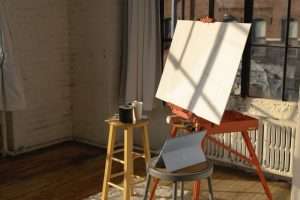DIY Acrylic Wall Art Painting Project: Tips for a Successful Do-It-Yourself Acrylic Wall Art Painting Project. If you want to learn the basics of how to paint wall art with acrylics, this is the place to go. The tips in this blog will make it easy to do your own wall art painting project.
If you’ve ever seen a painting on canvas that you liked and wanted to have it on your walls but didn’t have the money to buy it, here’s how you can easily do your own painting project! You can choose any canvas or surface (such as a piece of plywood) that is of the size that you want. Then apply two coats of gesso (a white ground) onto the canvas or surface that you are going to use. It should be applied with a paintbrush (never roll it on) so that the finish is smooth and even with no ridges or bumps left behind.
When the gesso has dried completely, start applying your acrylic paints onto your canvas or surface. Be sure to select colors that will go well together and complement each other. Apply one color at a time and wait for it to dry before applying another color beside it. The acrylic paint dries fast so this
There are many reasons to paint wall art with acrylics. For one, there are so many different mediums to choose from. It could be oil, watercolors, pastels or acrylics. You also have the option of painting abstract or realistic. So you can choose whatever feels right and what your heart desires.
TIP 1: Planning is Important
Before you get started on your project, you should figure out what you want to paint. The size of the space you want to fill is a big factor because this will determine the type of size you will use to create your painting.
You should also think of whether you want an abstract painting or realistic one. This will help you decide on which medium to use for your project.
TIP 2: Work on a Good Surface
It is important that you have a good painting surface for your project. Once again, it depends on what type of art style you will go for but there is always something to remember; always use a clean and smooth surface before painting anything on it.
TIP 3: Color Mixing and Schemes
Mixing colors may seem like an easy task but it can be quite difficult especially if the color you need does not seem to blend well with any of those
Have you just decide to paint the wall art in your home? Do you have the plans to do it with acrylic paints? Here are some useful tips for you which will make your acrylic paints painting projects successful.
Tackle a small project first:
The best thing about acrylic paints is that they are water based and thus can be washed off easily if you wish to do so. They also dry very fast and thus can be used on big walls as well.
However, the drying time varies depending on the thickness of the layer applied and also on environmental conditions like availability of air, humidity etc. In order to avoid making mistakes that may cost you a lot in future, it is better that you start with a smaller wall art project first. It will give you an opportunity to work out all your kinks before starting on a bigger one.
Acrylics can scratch or flake off:
Since acrylics are water based, they should not be used on wet surfaces or on surfaces where they may come into contact with moisture easily. This type of paint is not suitable for use on windows or glass doors because it may scratch or flake off after a while.
Prepare your wall surface properly:
Your wall surface should be clean and should have no traces
Painting wall art with acrylics can be rewarding and fun. The trick is knowing how to choose the right paint for your project.
First, don’t pick up a cheap, bargain brand of acrylic paint. You’ll have to use more coats of that paint in order to get the same effect you would from a higher-quality brand. I know that sounds counter-intuitive, but it’s true!
I like Golden brand paints, which are available at Michael’s craft store. They’re not cheap, but they go on smoothly, require fewer coats, and look great. In fact, after painting my guest room with Golden paints, my brother-in-law remodeled his house and used them throughout!
The second thing you need to know about painting wall art with acrylics is how to prep the surface before you start painting. It’s going to take longer than you think it will! I’m just warning you! You don’t want to be halfway through your project only to find out that you haven’t sealed the piece adequately and the paint is seeping into the existing finish or bleeding through it or whatever. You can read up on all kinds of ways to prepare surfaces for painting using different kinds of sealers and primers, so I won’t go
If you are a DIY project-lover, painting and decorating acrylic wall art is one of the best crafts that you can do to bring some color and creativity into your life. From pictures of abstract designs to wall hanging decorations, you can paint in any style and on any surface.
TIP 1: You can find an acrylic paint that works well with your chosen surface by looking at the label. If you want to paint on glass, for instance, look for a formula labeled “acrylic glass paint.” If you are painting on wood, search for a product called “acrylic wood finish.”
TIP 2: Acrylic paints are great for use on most surfaces because they dry fast. If you want to use them on textured surfaces like fabric or leather, spray the material with acrylic sealer before painting.
TIP 3: When prepping your surface before painting, make sure it’s clean and smooth from dust and grime. A tack cloth will remove any dirt or dust particles from the surface. Then wipe it down with rubbing alcohol to get rid of any grease or oils in the way.
All the wall art in your home should be chosen to fit together so that it looks like a complete design. A wall art painting can be very inspirational and fun to make. You may have a picture you took on vacation or something you drew yourself that would look good as a painting on canvas. Whatever you choose, there are some things to keep in mind to make sure your painting turns out great!
Here are tips for creating your own acrylic wall art:
1. Decide what kind of paint you want to use
Painting is a great way to decorate and express yourself so get the right kind of paint. Paint comes in many different kinds including water-based, egg tempera, oil-based, and acrylics. Oil is usually thought of as an artist’s paint because it is used in oil paintings; however, many people like using oil based paints for their versatility. Water-based paints are usually used as an alternative to oil-based paints; they are usually cheaper, but they don’t last as long or cover as well as oil-based paints do. Egg tempera means that the paint contains egg; this type of paint has been around for centuries and is thought to be one of the first types of paints created by humans. Acrylic
Painting with acrylics is a brilliant way to decorate your home; it’s cheap, easy and it gives you the freedom to experiment. In this article I am going to give you some tips on how to paint with acrylics and some advice on choosing the right colours for your project.
Tips:
1. It’s always good to paint something that you like; because if you don’t like it at least someone will!
2. Choose your colours carefully. When choosing bright colours take into account the colour of the room you are painting, otherwise it will look strange.
3. When painting abstracts, patterns or anything that doesn’t resemble a certain object make sure you have an image of what you want to paint next to you so that you can refer back if necessary.
4. Read the instructions on your paints carefully, lots of people make mistakes by using paints when they shouldn’t or using more than they need!
5. Don’t be tempted to use too much paint at once, make sure that each layer dries before adding another one otherwise the layers will run together and won’t look very good at all!
6. When painting abstracts it looks better if each colour has been applied in separate layers, this way they won’t


